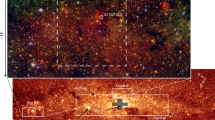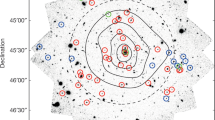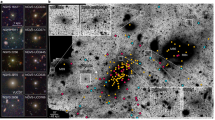Abstract
Within the early Universe, ‘extreme’ star formation may have been the norm rather than the exception1,2. Super star clusters (with masses greater than 105 solar masses) are thought to be the modern-day analogues of globular clusters, relics of a cosmic time (redshift z ≳ 2) when the Universe was filled with vigorously star-forming systems3. The giant H ii region 30 Doradus in the Large Magellanic Cloud is often regarded as a benchmark for studies of extreme star formation4. Here, we report the discovery of a massive embedded star-forming complex spanning about 500 pc in the unexplored southwest region of the Large Magellanic Cloud, which manifests itself as a younger, embedded twin of 30 Doradus. Previously known as N79, this region has a star-formation efficiency greater than that of 30 Doradus, by a factor of about 2, as measured over the past ~0.5 Myr. Moreover, at the heart of N79 lies the most luminous infrared compact source discovered with large-scale infrared surveys of the Large Magellanic Cloud and Milky Way, possibly a precursor to the central super star cluster of 30 Doradus, R136. The discovery of a nearby candidate super star cluster may provide invaluable information to understand how extreme star formation proceeds in the current and high-redshift Universe.
This is a preview of subscription content, access via your institution
Access options
Access Nature and 54 other Nature Portfolio journals
Get Nature+, our best-value online-access subscription
$29.99 / 30 days
cancel any time
Subscribe to this journal
Receive 12 digital issues and online access to articles
$119.00 per year
only $9.92 per issue
Buy this article
- Purchase on Springer Link
- Instant access to full article PDF
Prices may be subject to local taxes which are calculated during checkout




Similar content being viewed by others
References
Barger, A. J. et al. Submillimetre-wavelength detection of dusty star-forming galaxies at high redshift. Nature 394, 248–251 (1998).
Turner, J. L. Extreme star formation. Astrophys. Space Sci. Proc. 10, 215–246 (2009).
Kruijssen, J. M. D. Globular clusters as the relics of regular star formation in ‘normal’ high-redshift galaxies. Mon. Not. R. Astron. Soc. 454, 1658–1686 (2015).
Walborn, N. R. in The Magellanic Clouds, IAU Symp. Vol. 148 (eds. Haynes, R. & Milne, D.) 145 (1991).
de Vaucouleurs, G. & Freeman, K. C. Structure and dynamics of barred spiral galaxies, in particular of the Magellanic type. Vistas Astron. 14, 163–294 (1972).
Staveley-Smith, L., Kim, S., Calabretta, M. R., Haynes, R. F. & Kesteven, M. J. A new look at the large-scale Hi structure of the Large Magellanic Cloud. Mon. Not. R. Astron. Soc. 339, 87–104 (2003).
Bekki, K. & Chiba, M. Dynamical influences of the last Magellanic interaction on the Magellanic Clouds. Publ. Astron. Soc. Aust. 24, 21–29 (2007).
de Boer, K. S., Braun, J. M., Vallenari, A. & Mebold, U. Bow-shock induced star formation in the LMC? Astron. Astrophys. 329, L49–L52 (1998).
Murray, N. Star formation efficiencies and lifetimes of giant molecular clouds in the Milky Way. Astrophys. J. 729, 133 (2011).
Ochsendorf, B. B., Meixner, M., Chastenet, J., Tielens, A. G. G. M. & Roman-Duval, J. The location, clustering, and propagation of massive star formation in giant molecular clouds. Astrophys. J. 832, 43 (2016).
Henize, K. G. Catalogues of Hα-emission stars and nebulae in the Magellanic Clouds. Astrophys. J. Suppl. Ser. 2, 315 (1956).
Madden, S. C., Poglitsch, A., Geis, N., Stacey, G. J. & Townes, C. H. [C ii] 158 micron observations of IC 10: evidence for hidden molecular hydrogen in irregular galaxies. Astrophys. J. 483, 200–209 (1997).
Jameson, K. E. et al. The relationship between molecular gas, H i, and star formation in the low-mass, low-metallicity Magellanic Clouds. Astrophys. J. 825, 12 (2016).
Seale, J. P. et al. Herschel Key Program HERITAGE: a far-infrared source catalog for the Magellanic Clouds. Astron. J. 148, 124 (2014).
Mottram, J. C. et al. The RMS Survey: the luminosity functions and timescales of massive young stellar objects and compact H ii regions. Astrophys. J. Lett. 730, L33 (2011).
Zinnecker, H. & Yorke, H. W. Toward understanding massive star formation. Annu. Rev. Astron. Astrophys. 45, 481–563 (2007).
Walborn, N. R. & Parker, J. W. Two-stage starbursts in the Large Magellanic Cloud—N11 as a once and future 30 Doradus. Astrophys. J. Lett. 399, L87–L89 (1992).
Cignoni, M. et al. Hubble Tarantula Treasury Project. II. The star-formation history of the starburst region NGC 2070 in 30 Doradus. Astrophys. J. 811, 76 (2015).
Fukui, Y. et al. Molecular and atomic gas in the Large Magellanic Cloud. II. Three-dimensional correlation between CO and H i. Astrophys. J. 705, 144–155 (2009).
Malumuth, E. M. & Heap, S. R. UBV stellar photometry of the 30 Doradus region of the Large Magellanic Cloud with the Hubble Space Telescope. Astron. J. 107, 1054–1066 (1994).
Lee, E. J., Miville-Deschênes, M.-A. & Murray, N. W. Observational evidence of dynamic star formation rate in Milky Way giant molecular clouds. Astrophys. J. 833, 229 (2016).
Vutisalchavakul, N., Evans, N. J. II & Heyer, M. Star formation relations in the Milky Way. Astrophys. J. 831, 73 (2016).
Ochsendorf, B. B., Meixner, M., Roman-Duval, J., Rahman, M. & Evans, N. J. II what sets the massive star formation rates and efficiencies of giant molecular clouds? Astrophys. J. 841, 109 (2017).
Turner, J. L. et al. Highly efficient star formation in NGC 5253 possibly from stream-fed accretion. Nature 519, 331–333 (2015).
Ginsburg, A. et al. Toward gas exhaustion in the W51 high-mass protoclusters. Astron. Astrophys. 595, A27 (2016).
Crowther, P. A. et al. The R136 star cluster dissected with Hubble Space Telescope/STIS. I. Far-ultraviolet spectroscopic census and the origin of He ii λ1640 in young star clusters. Mon. Not. R. Astron. Soc. 458, 624–659 (2016).
Figer, D. F. et al. Hubble Space Telescope/NICMOS observations of massive stellar clusters near the Galactic Center. Astrophys. J. 525, 750–758 (1999).
Krumholz, M. R. in Very Massive Stars in the Local Universe. Astrophysics and Space Science Library Vol. 412 (ed. Vink, J. S.) 43 (2015).
Athanassoula, E. The existence and shapes of dust lanes in galactic bars. Mon. Not. R. Astron. Soc. 259, 345–364 (1992).
Johnson, L. C. et al. Panchromatic Hubble Andromeda Treasury. XVIII. The high-mass truncation of the star cluster mass function. Astrophys. J. 839, 78 (2017).
Fukui, Y. et al. Formation of the young massive cluster R136 triggered by tidally-driven colliding H i flows. Publ. Astron. Soc. Jpn. 69, L5 (2017).
Kim, S. et al. A neutral hydrogen survey of the Large Magellanic Cloud: aperture synthesis and multibeam data combined. Astrophys. J. Suppl. Ser. 148, 473–486 (2003).
Wong, T. et al. The Magellanic Mopra Assessment (MAGMA). I. The molecular cloud population of the Large Magellanic Cloud. Astrophys. J. Suppl. Ser. 197, 16 (2011).
Gaustad, J. E., McCullough, P. R., Rosing, W. & Van Buren, D. A robotic wide-angle Hα Survey of the Southern Sky. Publ. Astron. Soc. Pac. 113, 1326–1348 (2001).
Smith, R. C., MCELS Team. The UM/CTIO Magellanic Cloud emission-line survey. Publ. Astron. Soc. Aust. 15, 163–64 (1998).
Meixner, M. et al. Spitzer survey of the Large Magellanic Cloud: Surveying the Agents of a Galaxy’s Evolution (SAGE). I. Overview and initial results. Astron. J. 132, 2268–2288 (2006).
Meixner, M. et al. The HERSCHEL Inventory of the Agents of Galaxy Evolution in the Magellanic Clouds, a Herschel Open Time Key Program. Astron. J. 146, 62 (2013).
Whitney, B. A. et al. Spitzer Sage Survey of the Large Magellanic Cloud. III. Star formation and ~1000 new candidate young stellar objects. Astron. J. 136, 18–43 (2008).
Gruendl, R. A. & Chu, Y.-H. High- and intermediate-mass young stellar objects in the Large Magellanic Cloud. Astrophys. J. Suppl. Ser. 184, 172–197 (2009).
Seale, J. P. et al. The evolution of massive young stellar objects in the Large Magellanic Cloud. I. Identification and spectral classification. Astrophys. J. 699, 150–167 (2009).
Jones, O. C. et al. The SAGE-Spec Spitzer Legacy program: the life-cycle of dust and gas in the Large Magellanic Cloud. Point source classification III. Mon. Not. R. Astron. Soc 470, 3250–3282 (2017).
Robitaille, T. P., Whitney, B. A., Indebetouw, R., Wood, K. & Denzmore, P. Interpreting spectral energy distributions from young stellar objects. I. A grid of 200,000 YSO model SEDs. Astrophys. J. Suppl. Ser. 167, 256–285 (2006).
Heiderman, A. & Evans, N. J. II The Gould Belt ‘MISFITS’ Survey: the real solar neighborhood protostars. Astrophys. J. 806, 231 (2015).
Heyer, M. et al. The rate and latency of star formation in dense, massive clumps in the Milky Way. Astron. Astrophys. 588, A29 (2016).
Dunham, M. M. et al. Young stellar objects in the Gould Belt. Astrophys. J. Suppl. Ser. 220, 11 (2015).
Battersby, C., Bally, J. & Svoboda, B. The lifetimes of phases in high-mass star-forming regions. Astrophys. J. 835, 263 (2017).
Carlson, L. R. et al. A panchromatic view of NGC 602: time-resolved star formation with the Hubble and Spitzer Space Telescopes. Astrophys. J. 730, 78 (2011).
Kato, D. et al. The IRSF Magellanic Clouds Point Source Catalog. Publ. Astron. Soc. Jpn 59, 615–641 (2007).
Wright, E. L. et al. The Wide-field Infrared Survey Explorer (WISE): mission description and initial on-orbit performance. Astron. J. 140, 1868–1881 (2010).
Sewiło, M. et al. The youngest massive protostars in the Large Magellanic Cloud. Astron. Astrophys. 518, L73 (2010).
Gordon, K. D. et al. Dust and gas in the Magellanic Clouds from the HERITAGE Herschel Key Project. I. Dust properties and insights into the origin of the submillimeter excess emission. Astrophys. J. 797, 85 (2014).
Spitzer, L. Physical Processes in the Interstellar Medium (Wiley, New York, 1978).
Marx-Zimmer, M. et al. A study of the cool gas in the Large Magellanic Cloud. I. Properties of the cool atomic phase — a third H i absorption survey. Astron. Astrophys. 354, 787–801 (2000).
Dickey, J. M., Mebold, U., Stanimirovic, S. & Staveley-Smith, L. Cold atomic gas in the Small Magellanic Cloud. Astrophys. J. 536, 756–772 (2000).
Lee, M.-Y., Stanimirović, S., Murray, C. E., Heiles, C. & Miller, J. Cold and warm atomic gas around the Perseus molecular cloud. II. The impact of high optical depth on the Hi column density distribution and its implication for the Hi-to-H2 transition. Astrophys. J. 809, 56 (2015).
Bolatto, A. D., Wolfire, M. & Leroy, A. K. The CO-to-H2 conversion factor. Annu. Rev. Astron. Astrophys. 51, 207–268 (2013).
Roman-Duval, J. et al. Dust and gas in the Magellanic Clouds from the HERITAGE Herschel Key Project. II. Gas-to-dust ratio variations across interstellar medium phases. Astrophys. J. 797, 86 (2014).
Paradis, D. et al. Spitzer characterization of dust in the ionized medium of the Large Magellanic Cloud. Astrophys. J. 735, 6 (2011).
Shaver, P. A., McGee, R. X., Newton, L. M., Danks, A. C. & Pottasch, S. R. The galactic abundance gradient. Mon. Not. R. Astron. Soc. 204, 53–112 (1983).
Dickinson, C., Davies, R. D. & Davis, R. J. Towards a free–free template for CMB foregrounds. Mon. Not. R. Astron. Soc. 341, 369–384 (2003).
Bertoldi, F. & McKee, C. F. Pressure-confined clumps in magnetized molecular clouds. Astrophys. J. 395, 140–157 (1992).
Kauffmann, J., Pillai, T. & Goldsmith, P. F. Low virial parameters in molecular clouds: implications for high-mass star formation and magnetic fields. Astrophys. J. 779, 185 (2013).
Rosado, M. et al. Formation of the nebular complex N11 in the Large Magellanic Cloud. Astron. Astrophys. 308, 588–600 (1996).
Nayak, O. et al. Studying relation between star formation and molecular clumps on subparsec scales in 30 Doradus. Preprint at https://arxiv.org/abs/1608.05451 (2016).
Kroupa, P. On the variation of the initial mass function. Mon. Not. R. Astron. Soc. 322, 231–246 (2001).
Vaidya, K., Chu, Y.-H., Gruendl, R. A., Chen, C.-H. R. & Looney, L. W. A Hubble Space Telescope view of the interstellar environments of young stellar objects in the Large Magellanic Cloud. Astrophys. J. 707, 1417–1426 (2009).
Stephens, I. W. et al. Stellar clusterings around ‘isolated’ massive YSOs in the LMC. Astrophys. J. 834, 94 (2017).
Vacca, W. D., Garmany, C. D. & Shull, J. M. The Lyman-continuum fluxes and stellar parameters of O and early B-type stars. Astrophys. J. 460, 914 (1996).
O’dell, C. R., Valk, J. H., Wen, Z. & Meyer, D. M. Identification of velocity systems in the inner Orion Nebula. Astrophys. J. 403, 678–683 (1993).
Simón-Díaz, S., Herrero, A. & Esteban, C. in Revista Mexicana de Astronomia y Astrofisica Conf. Series, Vol. 18 (eds Reyes-Ruiz, M. & Vázquez-Semadeni, E.) 123–125 (2003).
Robitaille, T. P. in Massive Star Formation: Observations Confront Theory. Astronomical Society of the Pacific Conf. Series, Vol. 387 (eds Beuther, H., Linz, H. & Henning, T.) 290 (2008).
Calzetti, D. et al. The calibration of mid-infrared star formation rate indicators. Astrophys. J. 666, 870–895 (2007).
Krumholz, M. R. et al. in Protostars and Planets VI (eds Beuther, H. et al.) 243–266 (Univ. Arizona Press, Arizona, 2014).
Kruijssen, J. M. D. & Longmore, S. N. An uncertainty principle for star formation: I. Why galactic star formation relations break down below a certain spatial scale. Mon. Not. R. Astron. Soc. 439, 3239–3252 (2014).
Kennicutt, R. C. Jr., Bresolin, F., Bomans, D. J., Bothun, G. D. & Thompson, I. B. Large scale structure of the ionized gas in the Magellanic clouds. Astron. J. 109, 594–604 (1995).
Krumholz, M. R. & McKee, C. F. A general theory of turbulence-regulated star formation, from spirals to ultraluminous infrared galaxies. Astrophys. J. 630, 250–268 (2005).
Portegies Zwart, S. F., McMillan, S. L. W. & Gieles, M. Young massive star clusters. Annu. Rev. Astron. Astrophys. 48, 431–493 (2010).
D’Ercole, A., Vesperini, E., D’Antona, F., McMillan, S. L. W. & Recchi, S. Formation and dynamical evolution of multiple stellar generations in globular clusters. Mon. Not. R. Astron. Soc. 391, 825–843 (2008).
Bekki, K. Secondary star formation within massive star clusters: origin of multiple stellar populations in globular clusters. Mon. Not. R. Astron. Soc. 412, 2241–2259 (2011).
Schaerer, D. & Charbonnel, C. A new perspective on globular clusters, their initial mass function and their contribution to the stellar halo and the cosmic reionization. Mon. Not. R. Astron. Soc. 413, 2297–2304 (2011).
van der Marel, R. P. & Kallivayalil, N. Third-epoch Magellanic Cloud proper motions. II. The Large Magellanic Cloud rotation field in three dimensions. Astrophys. J. 781, 121 (2014).
Lopez, L. A. et al. The role of stellar feedback in the dynamics of H ii regions. Astrophys. J. 795, 121 (2014).
Author information
Authors and Affiliations
Contributions
B.B.O. performed the analysis, coordinated collaboration and wrote the manuscript. O.N. helped in characterizing H72.97-69.39. M.M. and O.C.J. helped with the creation of the MYSO catalogue and estimates of source contamination. H.Z., J.B., R.I. and M.R. provided help with the interpretation of the results and implications.
Corresponding author
Ethics declarations
Competing interests
The authors declare no competing financial interests.
Additional information
Publisher’s note: Springer Nature remains neutral with regard to jurisdictional claims in published maps and institutional affiliations.
Electronic supplementary material
Supplementary Information
Supplementary Figures 1–2
Rights and permissions
About this article
Cite this article
Ochsendorf, B.B., Zinnecker, H., Nayak, O. et al. The star-forming complex LMC-N79 as a future rival to 30 Doradus. Nat Astron 1, 784–790 (2017). https://doi.org/10.1038/s41550-017-0268-0
Received:
Accepted:
Published:
Issue Date:
DOI: https://doi.org/10.1038/s41550-017-0268-0



